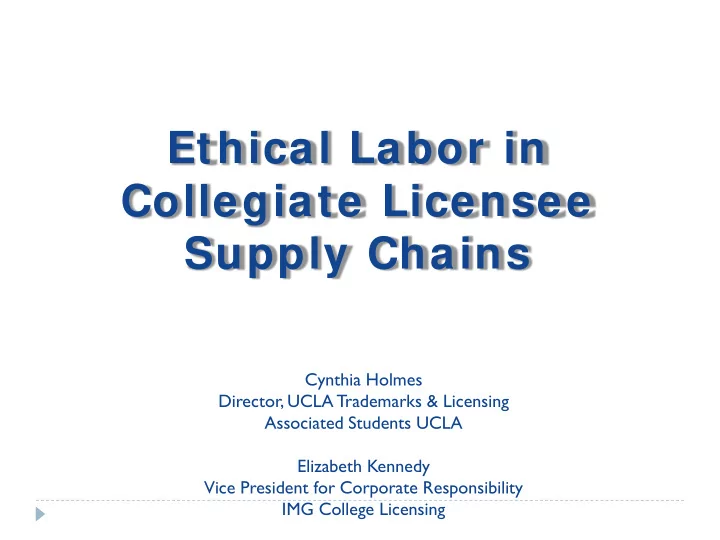

Ethical Labor in Collegiate Licensee Supply Chains Cynthia Holmes Director, UCLA Trademarks & Licensing Associated Students UCLA Elizabeth Kennedy Vice President for Corporate Responsibility IMG College Licensing
UC Tradem ark Licensee Code of Conduct UC Code Standards Address: • W age and Benefits • Hours of W ork • Overtim e Com pensation • Child Labor • Forced Labor • Health & Safety • Nondiscrim ination and W om en’s Rights • Harassm ent and Abuse • Freedom of Association and Collective Bargaining Requires: • Licensee Supply Chain Disclosure • Encom passes entire supply chain • Corrective Action of Non-com pliances http://policy.ucop.edu/doc/3000130/TrademarkLicensing
I m plem enting Code Standards Crisis Managem ent = Rearview Risk Managem ent = Proactive
W hat Does “Good” Look Like? Licensee senior leadership support Licensee labor code aligns w ith university labor code Transparent supply chain Beyond com m itm ent tow ard true im plem entation Credible assessm ents of factories Corrective action taken Assum es full responsibility
Measuring Licensee Readiness “…universities need to assume greater responsibility for labor rights in their licensing programs. Universities should screen potential suppliers for their capacity to manage labor rights challenges in their supply chains before licensing proposals are accepted and at the point of renewal. Schools like Michigan and UCLA are doing this, but more need to follow. Groups like the FLA and WRC can’t succeed if universities don’t assume greater responsibility and ownership for these issues.” — Michael Posner NYU Stern Center for Business and Human Rights October 2014
CR Survey Score - Risk The degree to which a licensee is managing the risk its supply chain poses for the Mitigation sorts of workplace rights conditions problems that university codes of conduct were designed to address. Score Supply chain identification, Risk Transparency Card familiarity, knowledge, and selection process are all factors that contribute to this score. Purchasing Practices
CRSurvey Score - Mitigation The degree to which a licensee is employing action steps designed to educate, identify, and mitigate supply chain non-compliances with the Mitigation university code. Examples include whether licensee: • has a code of its own that meets or exceeds the university’s code Score standards • has developed business systems Risk Transparency Card and processes through which these standards are implemented within its supply chain and which include relevant, credible training • positions its code as required or Purchasing voluntary Practices • has grievance mechanisms and their scope, monitoring and remediation activities
CR Survey Score - Transparency The degree to which a licensee is Mitigation being open about its business practices and supply chain partners. This is measured through the accuracy of its Score responses to the survey, verified through outside sources where Transparency Risk Card possible, and with the public, via websites and consumer information that the licensee and in some cases, its suppliers provide. Purchasing Practices
CR Survey Score – Purchasing Practices The degree to which a licensee's Mitigation procurement processes support and reinforce the attainment of university code standards throughout its own manufacturing Score facilities and those of its suppliers. Planning, forecasting, training, Risk Transparency Card length of supplier relationships, and reward systems for internal and contracted supply chain partners all contribute to this measurement. Purchasing Practices
Early Results of CR Survey 320 licensees in 2013 Promotional Product Licensee results Lower Risk Lower Risk Higher Remediation Lower Remediation Risk Higher Risk Higher Risk Lower Remediation Higher Remediation Mitigation
Licensee Selection Based on CR Survey Results Over Multiple Years Cancelation of licensees occurred only after multi- year efforts failed to elicit an increase in their level of engagement 1 4 5 Current Licensees
Ethical Labor Practices: ASUCLA Methodology Renew al Conditions Standardize Branding/Visual Identity Update factory disclosure Code alignment Training Supply chain mapping Compulsory monitoring program • Some licensees had never been to or monitored their factories • Coached corrective action • Significant non-compliances identified in many instances 12
2 0 1 7 CR Survey Results 135 current licensees Lower Risk Lower Risk Lower Remediation Higher Remediation Risk Higher Risk Higher Risk Lower Remediation Higher Remediation Mitigation
Project I m pact 2 0 1 3 2 0 1 7
Learnings A combination of communications including direct communications from university to its licensees is optimal Identifying specific conditions/deliverables such as mentored monitoring resources for licensees is good, insisting on participation is better Buyers (retail and internal campus purchasing) standing united with licensing renewal decisions gets better results Full engagement by licensees in mentored monitoring program and the ability to communicate this across the business and via the CR survey effects positive change
Accepting Responsibility
Cam pus Outreach
* SPECI AL NOTI CE* APPAREL ORDERS Review of typical apparel mill brand and retail brand blanks used in the promotional products industry and generally sourced through various intermediary suppliers reveals that most do not disclose their supply chain information publicly where UCLA licensees and consumers may access it. There are two exceptions identified so far who do publicly disclose their factories: Fruit of the Loom (includes Russell Athletic Jerzees, and Fruit of the Loom labels) Our Supply Chain | Fruit of the Loom , I nc. Hanes (includes Gear for Sports, Champion, and Hanes labels) hanesforgood.com Effective immediately, no further use of non-transparent apparel brands will be permitted. Please expect quotes from your preferred UCLA Licensee for promotional apparel products based on the referenced brands only. We will continue to engage with other apparel mills and brands in an effort to expand the list of transparent apparel options that may be used in the future. * * * * *
Recommend
More recommend